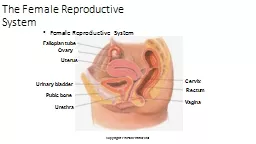

Copyright Pearson Prentice Hall The Female Reproductive System Fallopian tube Ovary Uterus Urinary bladder Pubic bone Urethra Vagina Rectum Cervix MEIOSIS forms the eggs ova ID: 539965
Download Presentation The PPT/PDF document "Female Reproductive System" is the property of its rightful owner. Permission is granted to download and print the materials on this web site for personal, non-commercial use only, and to display it on your personal computer provided you do not modify the materials and that you retain all copyright notices contained in the materials. By downloading content from our website, you accept the terms of this agreement.
Slide1
Female Reproductive System
Copyright Pearson Prentice Hall
The Female Reproductive System
Fallopian tube
Ovary
Uterus
Urinary bladder
Pubic bone
Urethra
Vagina
Rectum
Cervix Slide2
MEIOSIS forms the eggs (ova
)Each ovary contains about 400,000 primary follicles, which are clusters of cells surrounding a single egg. The follicle helps an egg mature for release into the reproductive tract, where it can be fertilized. Eggs develop within their follicles.https://www.youtube.com/watch?v=dwtFYOLFeNw Egg Development Copyright Pearson Prentice HallSlide3
When a follicle has matured, its egg is released in a process called
ovulation.The follicle breaks open, and the egg is swept from the ovary into one of the two Fallopian tubes.While in the Fallopian tube, an egg can be fertilized.After a few days, the egg passes from the Fallopian tube into the uterus.If the egg is not fertilized it passes through the cervix, and finally out of the vagina.The vagina leads to the outside of the body.Copyright Pearson Prentice HallSlide4
Mrs. Degl
Secondary Sexual Characteristics - FemaleInduced by increased LH, FSH, estrogen, and progesterone hormone levelsPubic hairWiden pelvisEnlarge mammary tissue (breasts)Begin menstrual cyclesSlide5
Female Reproduction
HormonesSlide6
Woman’s Cycle
Day 1 – Menstruation begins (bleeding)Day 5 – Menstruation is usually ended Day 14 – Ovum has matured and bursts out of the ovary Day 15 – After 24 hours the egg is done Day 26 – In the absence of fertilization, estrogen/progesterone levels drop and the endometrium lining breads down Day 28 – Menstruation begins again. Slide7
TIME LINE:
Ages 9-12 Secondary sex characteristics appearAges 11-14 Menstrual cycle beginsLate 20-30's Peak sexual urgesAges 45-55 Menopause (cycle stops, but sex urge continues)Slide8
Human Menstrual Cycle
Feedback – the production of one hormone influences the production of other hormones, either in a positive or negative feedbackSlide9
Feedback Mechanism
A Feedback Mechanism – is when the production of one hormone influences the production of other hormones, either in a positive or negative feedbackThe endocrine system uses a Feedback Mechanism to regulate the amount of hormones or chemical messages in the blood. This is basically a way of turning on or off the production of hormones in the body and maintaining Homeostasis or a steady state.When levels of one hormone or any chemical in the blood are to high or low it will trigger another hormone to be produced to help balance the chemical or hormone that is off.Slide10
Menstrual Cycle Terms
Menstruation – The body sheds the lining of the uterus (womb). Menstrual blood flows from the uterus through the small opening in the cervix and passes out of the body through the vagina Most menstrual periods last from 3 to 5 days.Follicle - In the female reproductive system, an ovarian follicle is a fluid-filled sac that contains an immature egg, or oocyteDuring ovulation, a mature egg is released from a follicle. While several follicles begin to develop each cycle, normally only one will ovulate an egg.The follicles that do not release a mature egg disintegrate and this can happen at any stage of follicular development.This is known as atresia. About 99% of ovarian follicles will disintegrate and never become mature enough to release/ovulate an egg.Corpus Luteum -
yellow hormone-secreting body in the female reproductive system. It is formed in an ovary at the site of a follicle, or sac, that has matured and released its
ovum, or egg,Slide11
Follicular Phase
During the follicular phase, an egg follicle on an ovary gets ready to release an egg. Usually, one egg is released each cycle. This process can be short or long and plays the biggest role in how long your cycle is. At the same time, the uterus starts growing a new endometrium to prepare for pregnancy. The last 5 days of the follicular phase, plus ovulation day, are your fertile window. This is when you are most likely to become pregnant if you have sex without using birth control.Slide12
Luteal Phase
This phase starts on ovulation day, `the day the egg is released from the egg follicle on the ovary. It can happen any time from Day 7 to Day 22 of a normal menstrual cycle. During ovulation, some women have less than a day of red spotting or lower pelvic pain or discomfort (mittelschmerz). These signs of ovulation are normal.If the egg is fertilized by sperm and then implants in (attaches to) the endometrium, a pregnancy begins. (This pregnancy is dated from Day 1 of this menstrual cycle.)If the egg is not fertilized or does not implant, the endometrium begins to break down. Slide13
Copyright Pearson Prentice Hall
The Menstrual Cycle
OvulationSlide14
Copyright Pearson Prentice HallSlide15
Female Reproductive System
Eggs mature in the ovariesMove from ovary through fallopian tube (oviduct) to uterusSlide16
Copyright Pearson Prentice HallSlide17
Fertilization
When sperm and egg unite, zygote is formedOnly one sperm can penetrate the eggEnzymes at tip of sperm allow it to penetrate egg’s outer coveringFertilization occurs in fallopian tubesSlide18
Fertilization
Zygote immediate starts dividing Slide19
Internal Development
Placenta – connects mother to fetusNutrients and wastes are exchangedBlood NEVER mixesAmniotic sac – filled with fluidFetus is enclosed in sacSlide20